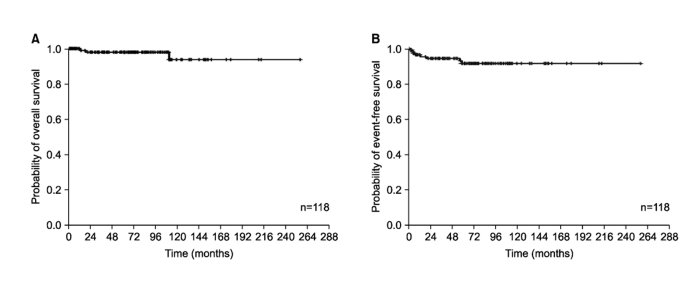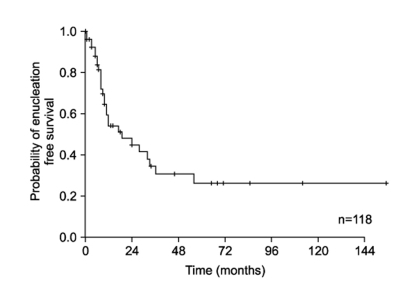Cancer Res Treat.
2008 Dec;40(4):164-171.
Clinical Results of Chemotherapy based Treatment in Retinoblastoma Patients: A Single Center Experience
- Affiliations
-
- 1Division of Hematology/Oncology, Department of Pediatrics, Cancer Research Institute, Seoul National University College of Medicine, Seoul, Korea. hyshin@snu.ac.kr
- 2Pediatric Oncology Clinic, Specific Organs Cancer Center, National Cancer Center, Goyang, Korea.
- 3Korea Childhood Leukemia Foundation, Seoul National University College of Medicine, Seoul, Korea.
- 4Department of Ophthalmology, Seoul National University College of Medicine, Seoul, Korea.
- 5Department of Therapeutic Radiology, Medical Research Center, Seoul National University College of Medicine, Seoul, Korea.
Abstract
-
PURPOSE: Retinoblastoma is the most common intraocular malignancy in children. Since the 1990s, chemotherapy was indicated for intraocluar disease to reduce the frequency of enucleation and spare the complications associated with external beam radiation. In this study, we analyzed treatment results of retinoblastoma in our institute.
MATERIALS AND METHODS
Datas from children diagnosed with retinoblastoma and treated at Seoul National University Children's Hospital between 1986 and 2008 were analyzed retrospectively. We utilized cyclophosphamide, vincristine, adriamycin, and methotrexate (CVAM) for OPD-based adjuvant chemotherapy. From 1990, primary chemotherapy was administered to patients with intraocular disease for eyeball-saving and patients received a combination of etoposide, vincristine, cisplatin (or ifosfamide) as a moderately intensive regimen, or a combination of cisplatin, doxorubicin, etoposide, and cycophosphamide (CDEC) as a highly intensive regimen.
RESULTS
One hundred eighteen children were analyzed. There were 68 unilateral and 50 bilateral diseases. The median age at diagnosis was 1 year and ReeseEllsworth stage V was the most common stage at the time of diagnosis. All patients were treated by chemotherapy-based multimodality methods, and primary chemotherapy was administered to 80 patients. The 10-year overall and event-free survival rate of all patients were 93.9% and 91.6%, respectively. Two patients who died were in the CDEC regimen group, but there was no significant statistical difference in survival rates by chemotherapy regimens. Fifty-six of 114 eyeballs were saved after primary chemotherapy-based treatment, and the eyeball-saving rate was 49.1%. Six patients relapsed after enucleation and 2 patients were treated successfully after autologous PBSCT. Osteosarcoma occurred in 2 patients as a secondary malignancy, and facial asymmetry after radiotherapy was the most common long-term sequelae.
CONCLUSIONS
In this study, the overall and event-free survival rates of retinoblastoma were satisfactory and eye-saving was possible with primary chemotherapy. Development of new chemotherapeutic regimens and a team approach are necessary to improve the eyeball-saving rate.
MeSH Terms
Figure
Reference
-
1. Ellsworth RM. The practical management of retinoblastoma. Trans Am Ophthalmol Soc. 1969; 67:462–534. PMID: 5381307.2. Phillips C, Sexton M, Wheeler G, McKenzie J. Retinoblastoma: review of 30 years' experience with external beam radiotherapy. Australas Radiol. 2003; 47:226–230. PMID: 12890239.3. Gombos DS, Chevez-Barrios AP. Current treatment and management of retinoblastoma. Curr Oncol Rep. 2007; 9:453–458. PMID: 17991352.
Article4. De Potter P. Current treatment of retinoblastoma. Curr Opin Ophthalmol. 2002; 13:331–336. PMID: 12218465.
Article5. Lee SH, Yoo KH, Sung KW, Kim JY, Cho EJ, Koo HH, et al. Tandem high-dose chemotherapy and autologous stem cell rescue in children with bilateral advanced retinoblastoma. Bone Marrow Transplant. 2008; 42:385–391. PMID: 18574441.
Article6. Matsubara H, Makimoto A, Higa T, Kawamoto H, Sakiyama S, Hosono A, et al. A multidisciplinary treatment strategy that includes high-dose chemotherapy for metastatic retinoblastoma without CNS involvement. Bone Marrow Transplant. 2005; 35:763–766. PMID: 15750608.
Article7. Yang MH, Eun SH, Park CS, Son JA, Kim JY, Ko JW, et al. A study of the Survival Rate of Childhood Cancer in Korea. Cancer Res Treat. 2001; 33:191–198.
Article8. Shields CL, Shields JA, De Potter P. New treatment modalities for retinoblastoma. Curr Opin Ophthalmol. 1996; 7:20–26. PMID: 10163455.
Article9. Abramson DH, Niksarli K, Ellsworth RM, Servodidio CA. Changing trends in the management of retinoblastoma: 1951-1965 vs 1966-1980. J Pediatr Ophthalmol Strabismus. 1994; 31:32–37. PMID: 8195960.
Article10. Kim JH, Yu YS, Khwarg SI, Choi HS, Shin HY, Ahn HS. Clinical result of prolonged primary chemotherapy in retinoblastoma patients. Korean J Ophthalmol. 2003; 17:35–43. PMID: 12882506.
Article11. Reese AB, Ellsworth RM. The evaluation and current concept of retinoblastoma therapy. Trans Am Acad Ophthalmol Otolaryngol. 1963; 67:164–172. PMID: 13973597.12. Akiyama K, Iwasaki M, Amemiya T, Yanai M. Chemotherapy for retinoblastoma. Ophthalmic Paediatr Genet. 1989; 10:111–116. PMID: 2779981.
Article13. Campinchi R, Lemerle J, Bloch-Michel E, Pinget T, Schweisguth O, Luker P, et al. Does chemotherapy have a role in the treatment of retinoblastomas? BullSoc Ophtalmol Fr. 1976; 76:17–22.14. Matthay KK, O'Leary MC, Ramsay NK, Villablanca J, Reynolds CP, Atkinson JB, et al. Role of myeloablative therapy in improved outcome for high risk neuroblastoma: review of recent Children's Cancer Group results. Eur J Cancer. 1995; 31A(4):572–575. PMID: 7576971.
Article15. Han SB, Kim JH, Choung HK, Kim SJ, Khwarg SI, Yu YS. The clinical courses of retinoblastoma patients who underwent bilateral enucleation. J Korean Ophthalmol Soc. 2007; 48:1234–1241.
Article16. Chintagumpala M, Chevez-Barrios P, Paysse EA, Plon SE, Hurwitz R. Retinoblastoma: review of current management. Oncologist. 2007; 12:1237–1246. PMID: 17962617.
Article17. Lee V, Hungerford JL, Bunce C, Ahmed F, Kingston JE, Plowman PN. Globe conserving treatment of the only eye in bilateral retinoblastoma. Br J Ophthalmol. 2003; 87:1374–1380. PMID: 14609838.
Article18. Migdal C. Bilateral retinoblastoma: the prognosis for vision. Br J Ophthalmol. 1983; 67:592–595. PMID: 6882716.
Article19. Sanders BM, Draper GJ, Kingston JE. Retinoblastoma in Great Britain 1969-80: incidence, treatment, and survival. Br J Ophthalmol. 1988; 72:576–583. PMID: 3415951.
Article




